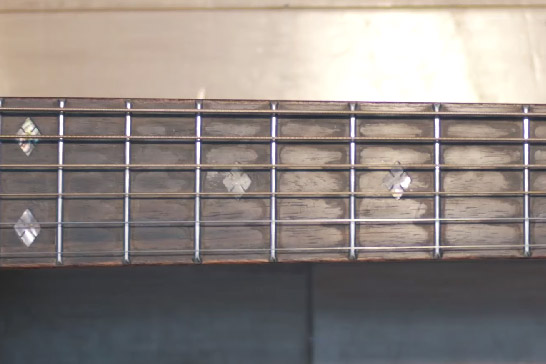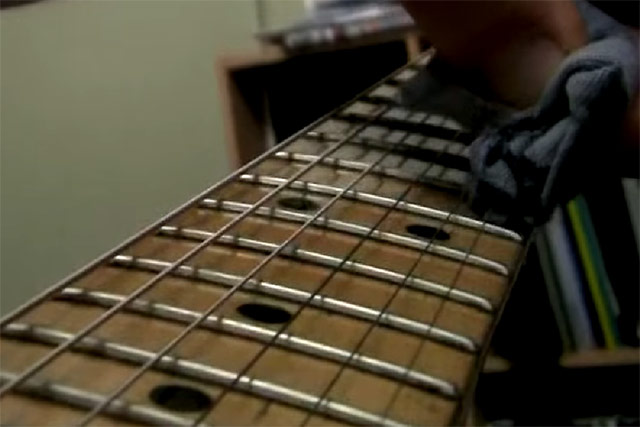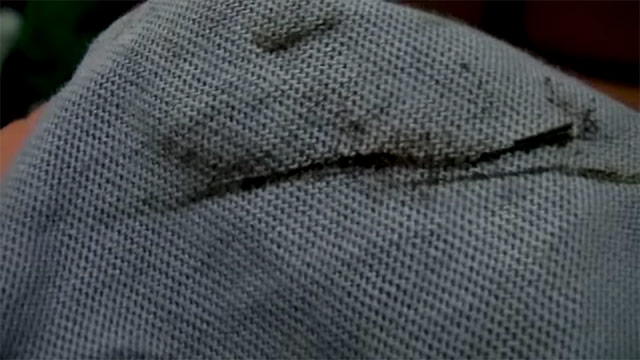Some people love the sound of a new set of guitar strings, while others like how the older strings sound. If you like a bright, treble–rich tone, you would be changing strings quite frequently. On the other hand, if you love the mellower sound and the feel of older strings, you might be able to go several months on end without having to restring your guitar.
While the preference is up to you, there are times when the strings become “dead” (in the way they sound), past their best sound–producing life, and you should consider changing them. Many beginners and casual players keep playing their older strings without realizing that the guitar is probably sounding very different from when they bought it.
The strings’ tone deteriorates over time, and you wouldn’t be the only person who didn’t notice this until, one day, a string snapped while playing. This is usually long after the strings actually “died” or stopped producing their optimal sound output.
In this article, we’ll discuss many signs that tell you in advance if you need to have your guitar restrung to keep playing it in its best condition.
Brand new strings produce a treble–y sound which can be anything between bright to tinny, depending on the strings. Some guitarists love the brighter sound, while others believe that the strings produce thier best sound after a few days of “breaking in.” The strings stay at their best for another month or two in case of moderate use before starting to deteriorate slowly, but it will also depend largely on the type of string. Most strings will remain in good playable condition for another couple of months before requiring a change.
Please do note, however, that there are a lot of variations in terms of string material, quality, gauge, and the player’s skin chemistry, like sweat and oil secretions which would affect how long a set of strings would be in their best shape. The detailed discussion below will help you find this for yourself and your guitar.
How to Tell If My Guitar Strings Are Dead?
Fretboard is Dirty

Our fingers produce oils and sweat, and combined with the pollution and dust in the air, the strings and fretboard have to deal with a lot of abuse. The fretboard is generally cleaned with a cleaning solution when a new set of strings are put on a guitar. If you had your guitar restrung by a professional, chances are that they cleaned it.
For this check, we’ll assume a thorough cleaning was either done at the time of restringing or that your guitar is new. Either way, look closely at the fretboard, particularly closer to the nut (if you play chords and chord progressions). If you find gunk or sludge forming, it can indicate that you have probably played the strings long enough to warrant a change.
Strings Are Discolored
It is usual for strings to get discolored after a while due to being in constant contact with dirt, pollution, and body secretions. However, the discoloration should be on the surface level, meaning they should be gone after a good wipe (we recommend using a microfiber cloth). If the splotches are still there for the most part after cleaning, it could indicate that the string is past its prime and probably needs changing.
Some places, like the tuning pegs and near the bridge, are where you can see the original color of the strings for reference. Most decent–quality electric guitar strings have a silver luster, while acoustic strings have a golden–bronze shine. Remember, strings get discolored in their normal course and can be perfectly playable. However, if you suspect they could have gone bad, check the underside of the strings.
Grime on The Underside of the Strings


Take a white or light–colored cloth and wipe the underside of the string. To do this, slide the cloth under one of the strings and take it out from the other side, essentially wrapping the string in the cloth. Then slide the cloth up and down for the part of the frets most played. Now check how dirty or clean the cloth looks. If there is a lot of gunk and sludge, it might be time to change the strings. You can also use a similar method to clean all of your strings.
You can also use warm water and dip the cloth before wiping the strings. However, it is not recommended to use soap unless you can clean it off properly with just water a couple of times. Any residual soap will accelerate the natural corrosion process, which is certainly not good.
Guitar Can’t Keep Its Tuning
This problem can affect your guitar for a variety of reasons which have nothing to do with the strings. Moreover, if that’s the case, other issues, such as your guitar starting to sound dull (see next point), may even be caused by it.
If you’re sure there are no issues with your tuning pegs, bridge (especially in the case of an electric guitar), or nut, then the strings might be the culprit. Both brand–new strings and older ones about to give out are prone to tuning instability. In case you are facing tuning issues along with one or more other signs mentioned here, it might be time to have your strings changed.
It is generally advisable to stretch the brand–new strings once you have put them on. In short, once you have the new string in place and tune, press down your index finger like you’re trying a barre chord and press down all the strings. Now, one by one, start lifting the strings off the fretboard several times. Do this gently for each string a couple of times. After this process, you’ll need to tune the strings once again, but you’ll notice that they hold the tuning better.
Guitar Sounds Dull
Some guitarists like the mellow tone that the strings start to produce after the “break in” period, but if you are a casual player, you might not notice until someone points out that your guitar sounds too mellow or dull. If you don’t remember last changing the strings or it has been a while, and you also see visible signs of overuse (discussed next), it might be time to change your old guitar strings.
If you’re someone that plays the guitar frequently, you’ll notice the dull or dead tone the string produces when strummed. Listen closely — does your tone have a pop? Does it resonate well? Does it have enough sustain? If not, you might want to change your strings. It would be more subtle in the case of electric guitars, particularly if you use more effects. For electric guitar players, I’d recommend connecting the guitar directly to the amp in the clean channel with a low–mid volume and no other effects to get a clearer natural sound of the guitar. For acoustic guitarists, the change in tone should be obvious, even though it happens over a period of time.
Your Fingers Get Oily/Grimy While Playing
While being a chore, some guitarists like to wash their hands before they start playing the guitar. Doing this certainly has significant benefits since the strings come in contact with less dirt, sweat, and oils this way, particularly for some of us who have naturally sweaty/oily fingers. However, what about that nasty feeling of grease and grime you get after you put the guitar down at the end of a practice session? If this is something that you have had to endure, you’d have noticed the urge to wash your hands. In this case, you can try cleaning the strings and see if it makes any changes. If it doesn’t, your only bet would be to change the strings. While dirt and grime are a normal part of the wear and tear of strings cleaning them periodically and washing your hands can slow this down.
How Long Do Guitar Strings Last?
Also check out: Do Guitar Strings Go Bad in Their Package?
Unfortunately, there is no definitive answer to this. It depends on many factors, including string type, coating, skin chemistry, style and frequency of playing, etc. Just too many variables to make a generalized recommendation. However, I’d still like to give some general guidelines that you can use along with the signs of dead strings we discussed above and common sense to figure out if your strings need changing.
Regular, inexpensive strings (not the cheapest ones) would last anywhere from a few weeks to a couple of months, depending on how much you play and how aggressive it is. In most cases, you’d be able to notice the drop in tonal quality and the lack of tuning stability which would be sure signs of the strings going bad.
In addition to sounding slightly different and holding the bright sound for far longer, decent coated strings will also last for several months, even in heavy use. Some people, however, do not like the sound of these strings.
Expensive strings will generally last longer, around two to four months, before their sound starts to deteriorate. Coated strings would last even longer, but they might sound different depending on the coating material used.
Tone of Old vs New Guitar Strings
Brand–new guitar strings sound bright, almost tinny in some cases, and need several days of “breaking in” to sound “right” (for most people). Some people like the bright sound of new strings, which is why they change it regularly. It suits their preference and music style, and they even change the strings before every gig.
Others don’t like the tone of new strings and prefer older strings for performances. Strings start to sound mellow and “dull” after a few weeks of use, the guitarists who like playing with older strings argue that older strings lose the harsh sound and start to sound fuller and with more low end. Lovers of older strings also prefer flatwound strings, which have a mellower sound from the get–go and become even mellower with time.
Related Questions
Why Do Guitar Strings Go Dead?
Dirt, corrosion from air, chemicals secreted from the skin, etc., and normal wear–and–tear are why guitar strings go dead. It may speed up the process if you live in a place with high humidity or have more than normal secretions of sweat and oils. To prevent or minimize the extra damage, you can try washing your hands with soap and water before playing the guitar and regularly cleaning the strings with clean, warm water with the help of a microfiber cloth. Ordinary cloth may introduce lint that might get caught in the winding of the strings (the thicker two or three strings in a set).
How to Fix Dead Guitar Strings?
Unfortunately, there is no way to fix dead strings, you might try cleaning or boiling them to get a few more days out of them, but in many cases, it won’t help much with the dull tone. Strings are not very expensive, so I’d recommend changing them when they are dead and keeping another set handy if you’re going for a gig or performance.
Is It Safe to Boil Guitar String?
Yes, it is safe to boil strings; many guitarists and bassists do it. To do this, you’ll have to take the strings off your guitar, form a loop and boil it in clean (preferably distilled) water for around 10–15 minutes. This will take all the grime, dirt, and oil off the strings. Be sure to dry the strings completely before you restring the guitar.


